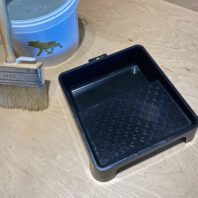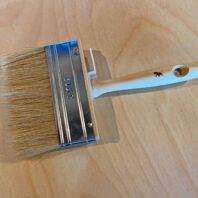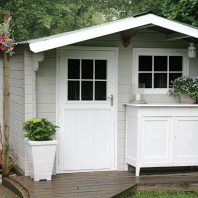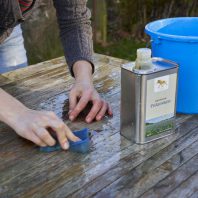Painting a summer house or garden shed
Colour and paint advice for the very best summer house
Super sleek, idyllic Swedish or a robust country house style, classic grey or very colourful – a summer house can have many different colours and styles.
With a paint later you determine the appearance of your garden shed or summer house and offer an effective protection against weather influences at the same time.
Moose Färg is a practical, durable wood paint that extends the life of your garden house. Because the paint absorbs into the wood, the charming wood grains remains visible. The paint is very easy to apply and generally requires no maintenance for 5 years.
- Protects the wood like a stain, while giving it an opaque colour like a paint
- Scandinavian matte colours
- Environmental, human and animal friendly
- Pleasant and easy to use
- Very easy to maintain, without sanding
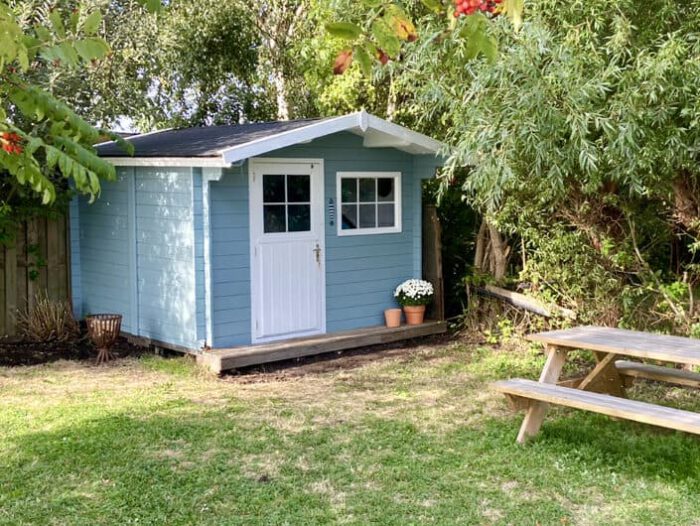
Want to paint your summer house? Choose Moose F wood paint:
Which stain or paint for your summer house?
A garden shed can have many styles. What do you choose?
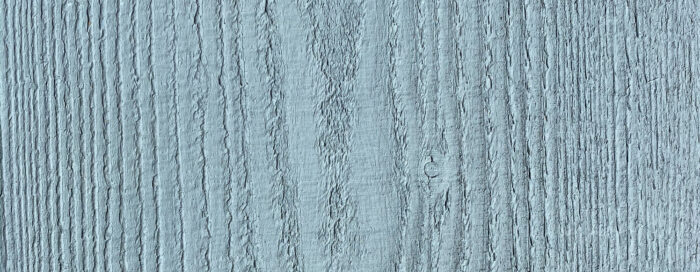
You can opt for a fully opaque paint: Moose F. This beautiful, matt paint absorbs into the wood so that the wood structures and grains remain beautifully visible. This paint type is not a lacquer and does not put a sealing layer on top of the wood. The wood retains its natural appearance. Because Moose F is fully opaque, your wood will be best protected against UV rays. View all Moose F colours.
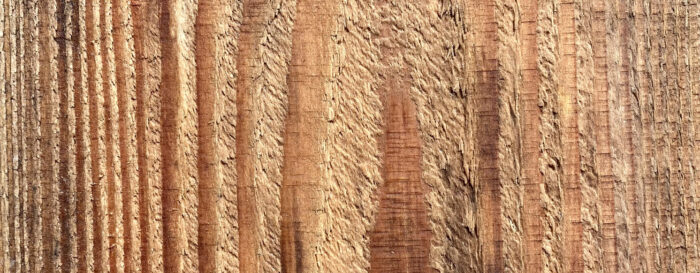
The transparent Storuman Skydd leaves the wood grain fully visible and is colourless. This transparent ‘sunscreen’ protects the wood for – on average – five years. It slows down wood greying, but does not prevent it in the long term. If you want to slow down the greying process, it needs to be refreshed regularly. Sometimes even every year, as the UV block gets absorbed at some point. Storuman Skydd is also widely used for the inside of a garden shed, where it increases durability and prevents yellowing.

If you want a transparent paint with a dash of colour, you can choose Dimma. This gives a ‘haze’ over the wood in the desired colour. Because the paint is semi-transparent, the wooden surface remains partially visible. The original colour of the wood therefore partially determines the final appearance. Dimma is available in all standard colours: grey wash or white wash is possible but so is Falu Röd wash!
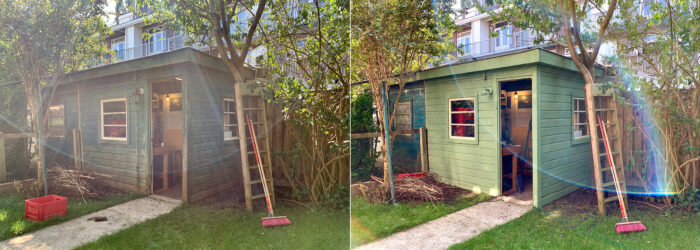
Maarten (Amsterdam): “Garden has been given a whole new look. From a dark old 30s shed to a cheerful corner at the back of the garden. Brushed the shed clean with a broom and dustpan and set to work. Second coat was on within 2 hours and the second coat within 1 hour. The block brush really makes a difference compared to a standard construction market brush. Don’t overthink it, just do it, it’s well worth the money.” Translated from Dutch.
A good surface ensures a good paint job
An important condition for good paintwork is that the wooden surface is in good condition.
- The moisture content of the wood is ideally around 17%. It is important to ensure that the wood does not have a high moisture content or that the core of the wood is not yet well balanced with the surface. On the other hand, if the wood is too dry, the paint will absorb too much paint and you will need many coats to get an opaque result.
- Pay attention to the construction of your garden house. The design should be done professionally. This is especially important for the wood being able to breathe. The garden houses should not be placed directly on the ground, condensation will form on the back of the boards and this will result in rot over time.
- If you do not isolate the (down) roof, the underside of the roof remains cold, causing constant condensation. This leads to mould. The wood should be free of mould. You can use an anti-fungal agent if necessary for these parts to prevent, but it is better to have a solid construction.
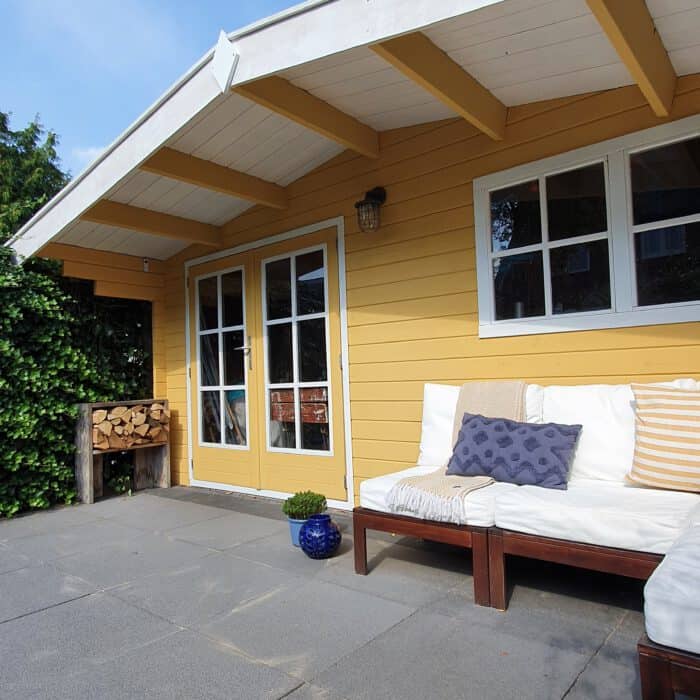
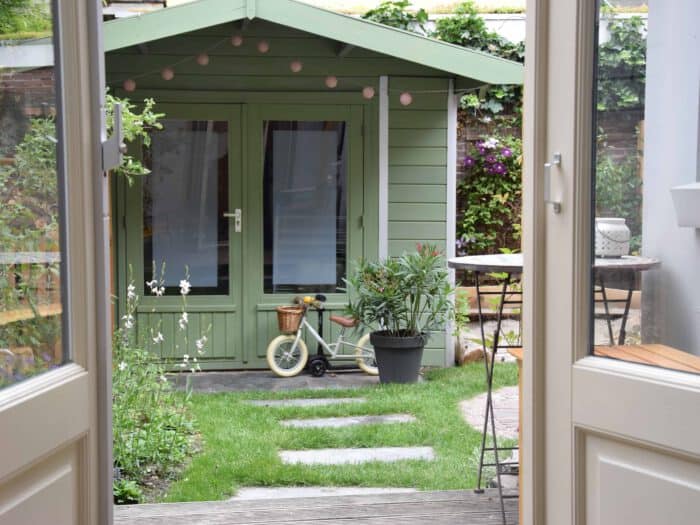
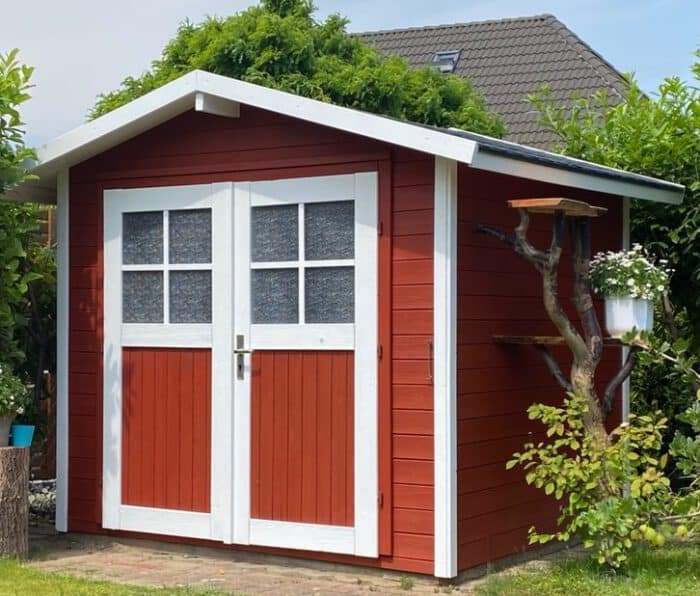
Step-by-step summer house painting:
The walls of garden sheds are often made of spruce, Douglas fir, larch or pine. Sometimes it is impregnated or already stained or painted.
A good pre-treatment is essential for adhesion of the paint in the long term. Below, we go through all the steps to create a durable result.
- Remove any old paint layers
If you are going to repaint an already painted or stained summerhouse, check the old paint layer carefully for cracks or flaking. An existing paint or stain layer that is still in good condition will not have any cracks or flaking. It is very important that the old paint layer does not flake or will not flake later on. If the old layer is still good, you can sand it well with 80-grit paper.
When the old paint is peeling, remove all loose paint completely. You can, for example, use a high-pressure sprayer (use the spray setting so that the wood grain will not be damaged) or a wire brush. This is how you remove the old paint from your garden shed. Of course, you can also do this with coarse-grained sandpaper (60 or 80). Sand in the direction of the wood fibre and remove the dust with water after sanding.
Allow the wood to dry thoroughly and then roughen it again slightly, so that the Moose Färg paint layer will adhere perfectly later and the old paint will not flake. If you want or need to do it more thoroughly, you can also burn off the paint with a heat gun. - Repainting an old, weathered summer house
Wood exposed to weathering becomes grey and porous due to dead wood cells. For the best results, remove the dead wood cells by e.g. using the high-pressure sprayer with a lather of Polarsken linseed oil soap.
- Important aspects with new, fresh wood
If your wood is fresh from the construction store, chances are that the wood has not yet been dried to the core. The wood will still shrink and expand and cracks will appear. Some types of wood will also have resin coming out of it. Leave fresh wood outside for a few weeks/months before painting. However, if you prefer to apply a protective coating immediately, you can paint 1 coat and wait a couple of weeks/months before applying the second coat.
At a timber store, the wood is placed in such a way that it is already dried to the core by the time it arrives at your home. You can then start painting immediately.
Tip: Is your summer house not yet assembled? Paint the first layer before assembling. This way, you can easily reach cracks and edges.
Also, always check new wood for traces of mould. - Degreasing and removing dirt from treated wood
Degrease freshly impregnated wood, for example with Polarsken soapy water. Wood that has been standing for quite some time already is also best cleaned with soapy water before painting.
- Sanding planed wood
Sand planed wood with coarse sandpaper (80-grit paper).
You do not need to sand wood that is already rough, e.g. sawn wood or wood that has been standing for years and is weathered. - Painting
Painting is child’s play: dilute the paint with water (5-10%) and apply a layer with a block brush.
Tip: if you are not going to use the entire paint bucket, pour some paint into a paint tray and clean and close the pot tightly. This will allow you to store the paint the longest.
Wait until the first layer is dust-dry and then paint the second layer. Drying time depends on temperature and humidity. Make sure the day temperature is above 15 degrees, then the paint layer will be re-paintable after 24 hours and fully waterproof after 3 days. It should not rain in the meantime. At higher temperatures, the paint dries faster. - Cleaning brushes
You can easily clean brushes with water and some soap. If you want to keep your brushes for the long term, you can rinse them with benzene.
If you have leftover paint, immediately reseal the pot and store it in a dry place with a temperature between 5 and 15 degrees. The paint must not freeze, then it will become unusable.
Products for painting your outdoor shed:
-
Paint tray 20 x 20 cm€1,50
-
Block brush (bristle)€14,50
-
Moose F paint for all types of wood€102,95
-
Polarsken linseed oil soap organic cleaner€16,95
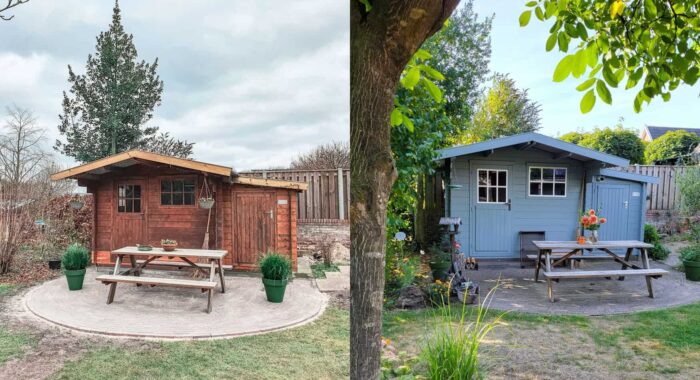
Choosing the right colour for your summer house
Moose Färg colours are from Sweden and are all completely matt. The colours may have a different appearance in different types of daylight. Don’t be fooled by your monitor’s settings and take a look at multiple photos or request our hand-painted colour card to get a good impression of the colours you have in mind.
Protecting your summer
house with breathable paint
Why painting your garden shed or summer house is important:
- Temperature differences. Damp wood expands and it shrinks as it dries. This often causes cracks in the wood. This is particularly the case with “open” wood types such as Douglas fir, pine, spruce and larch. The wood becomes more stiff as well, as the oils that are naturally present in wood disappear over time. This increases the risk of cracking and breaking of the wood. Make sure to choose a paint type that matches with this characteristic.
- UV beams. Exposure to the sun causes wood to weather and discolour. Heavy rain and wind can also affect the wood.
- Wood mould and algae like to settle in damp wood. It does not look appealing, but it can also affect your wood in the long term and cause wood rot. Therefore, it is important to choose a moisture-regulating paint like Moose F.
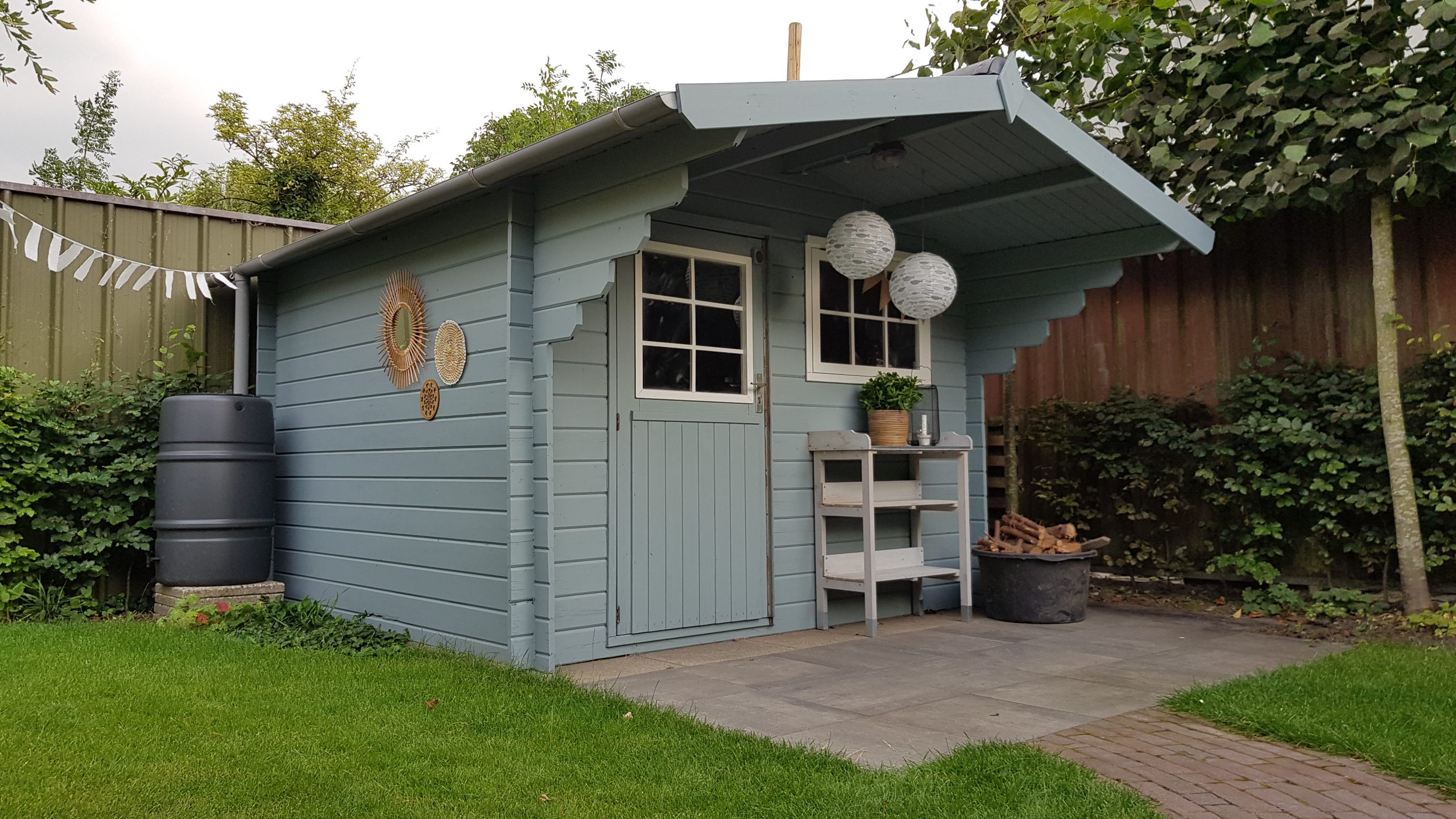
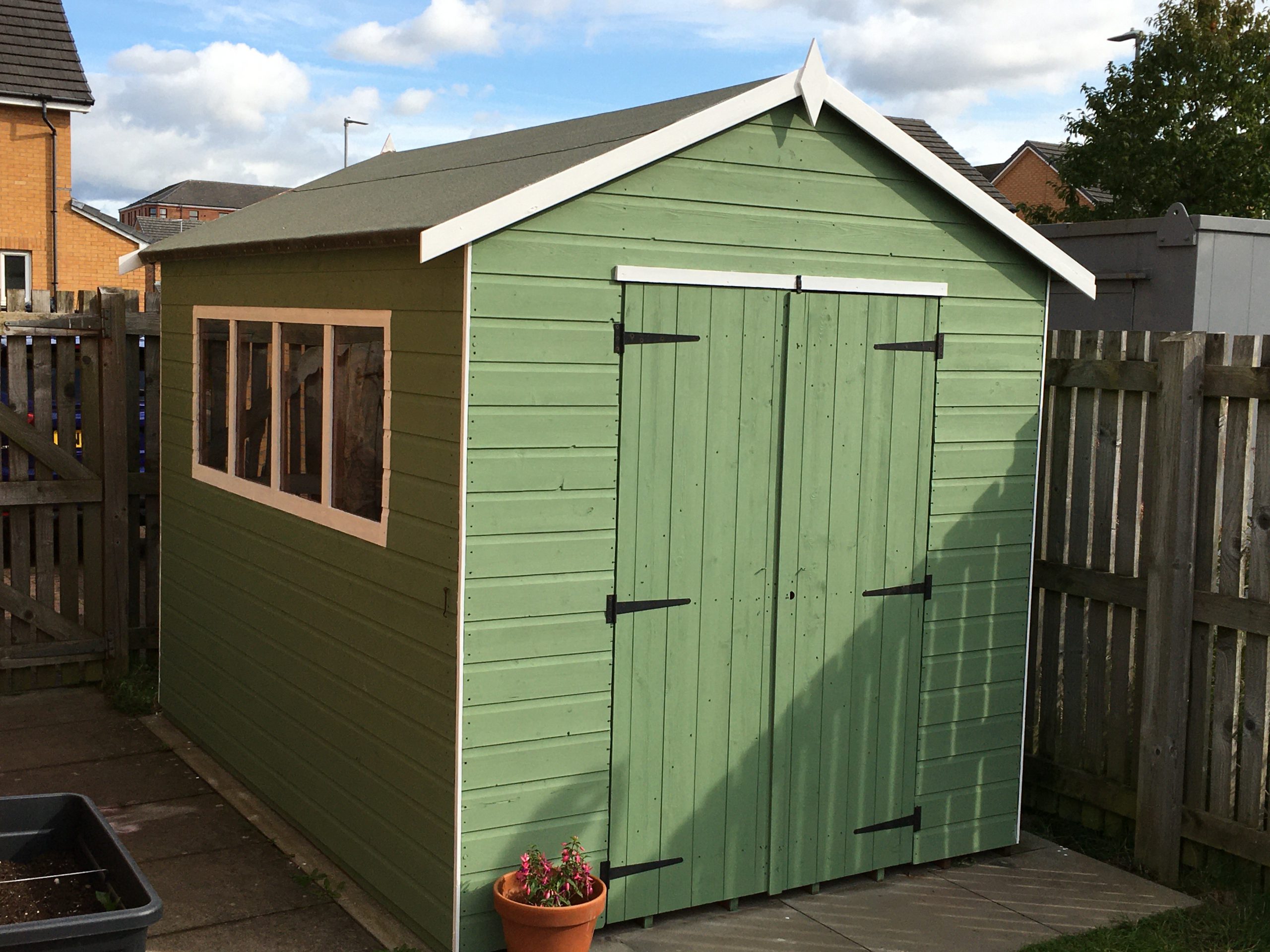
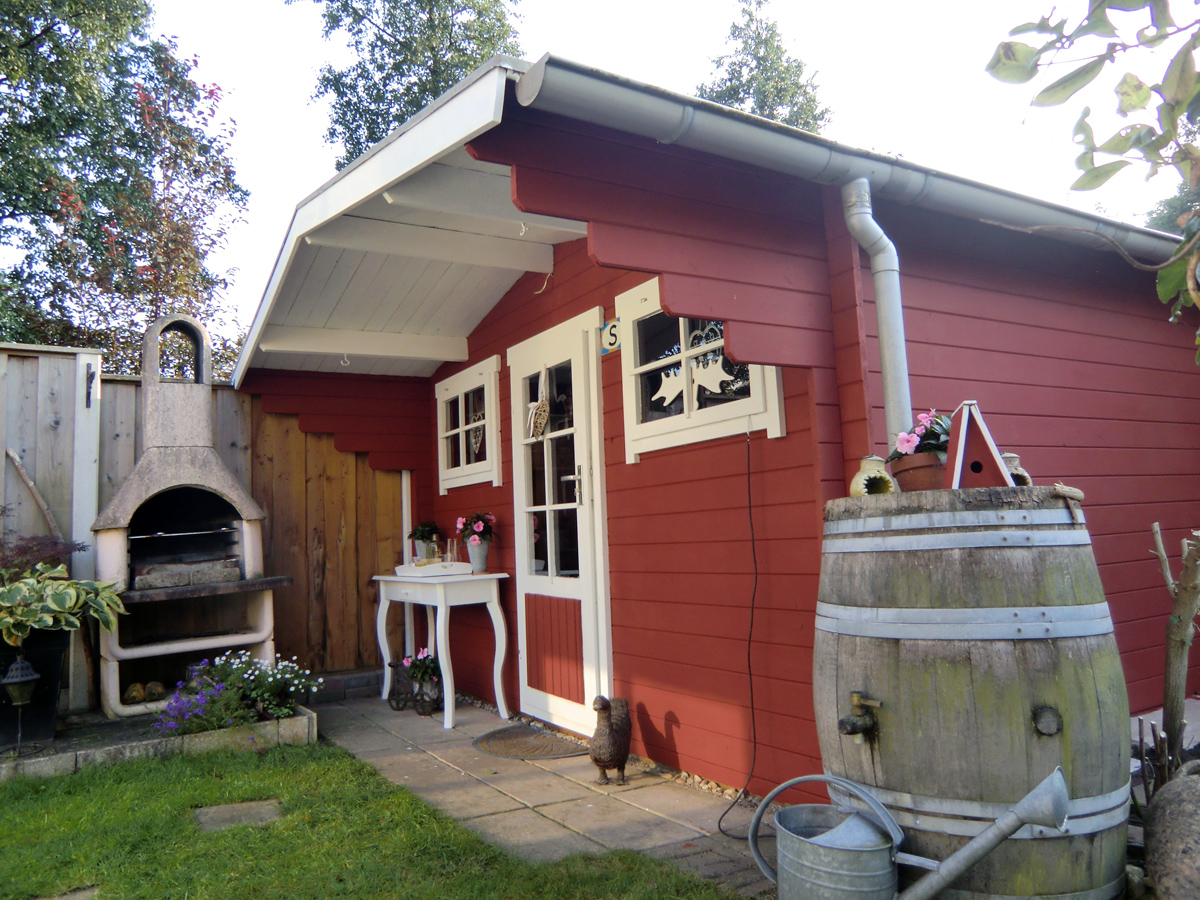
Advantages of Moose Färg paint for your summerhouse:
- Longer lifespan. Moose Färg’s garden shed paint protects your garden shed from weather conditions, such as rain and UV rays from the sun. Moose Färg products regulate moisture and do not put an sealing film-layer on top of the wood. It creates a vapour-permeable layer, which allows the wood to breathe. This extends the life of your wooden summerhouse.
- The wood keeps it’s authentic characteristics. Moose Färg paint absorbs into the wood, leaving the wood grain visible. Even when you choose for our opaque Moose F, the character of the wood remains visible.
- Pleasant to use. The paint does not smell, can be applied directly to the wood (no primer needed!) and can be applied easily with a block brush. No need to ask a professional painter, you can absolutely do it yourself.
- Easy maintenance. Under normal conditions and good pre-processing, you only need to paint your garden shed once every 5 years. Maintenance is easy: just clean with soapy water (e.g. use Polarsken linseed oil soap). No need for sanding when you want to repaint your summerhouse: just apply a new layer of paint. Usually, one coat is sufficient and you are ready to enjoy your garden shed for another 5 years.
- Unique Scandinavian matt colours. Moose Färg colours are vibrant. They look different, depending on the daylight. Because they are completely matt, they do not reflect sunlight and have a calm appearance. The Swedish colours, including the famous Swedish red, are a feast for the eyes.
- Environmentally, human- and animal-friendly. The composition of our paint is highly sustainable. With our paint, you can handle paint and wood sustainably. When re-painting with Moose Färg, you don’t have to sand. This means: no paint residues entering the environment.
Painting your garden shed with matt wood paint?
Inspiration for painting your summer house
On our website, you will find a beautiful collection of photos from customers who sent us their painted projects. Moose Färg paint is suitable for various types of wood, both untreated and already treated wood. Garden sheds made of Douglas fir, pine, spruce and larch can all be painted perfectly with our wood paint.
Below, we have highlighted some beautiful pictures of Moose Färg customers who painted their summer houses with colours from the Swedish colour palette.
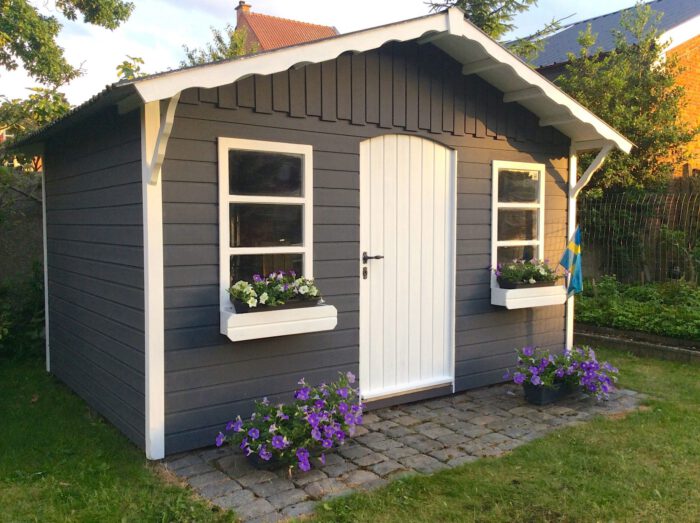
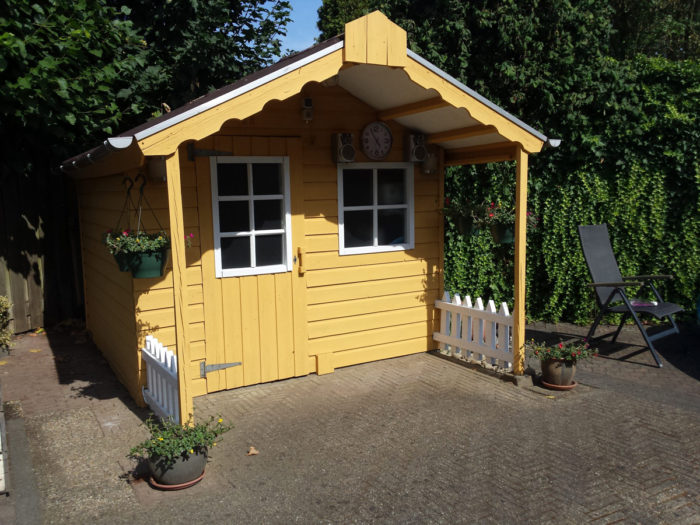
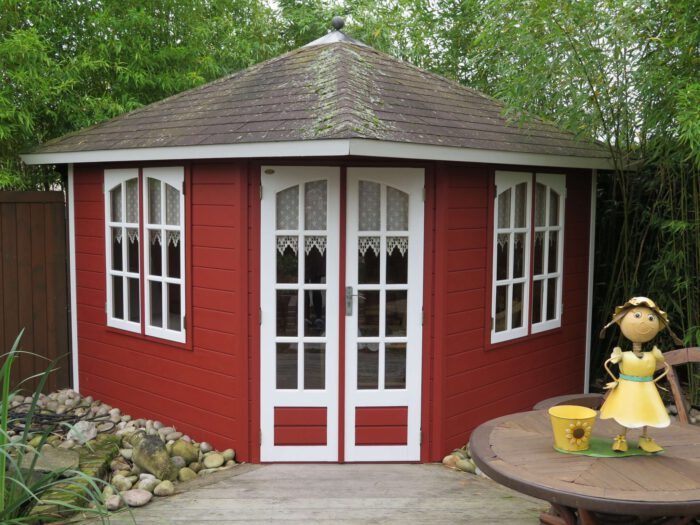
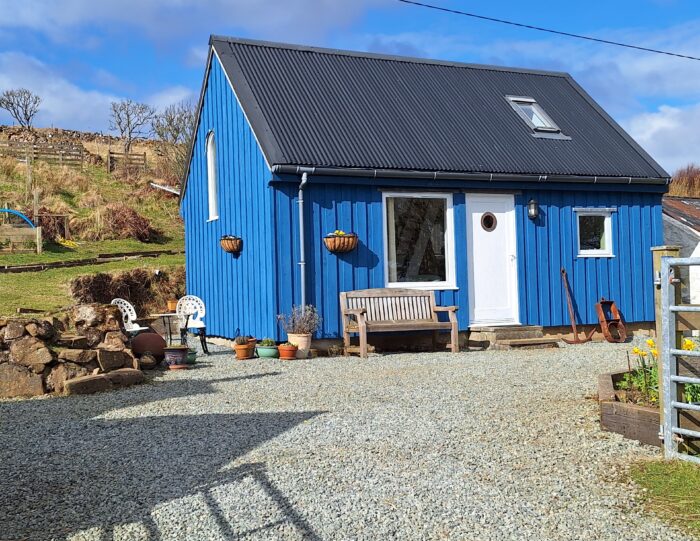
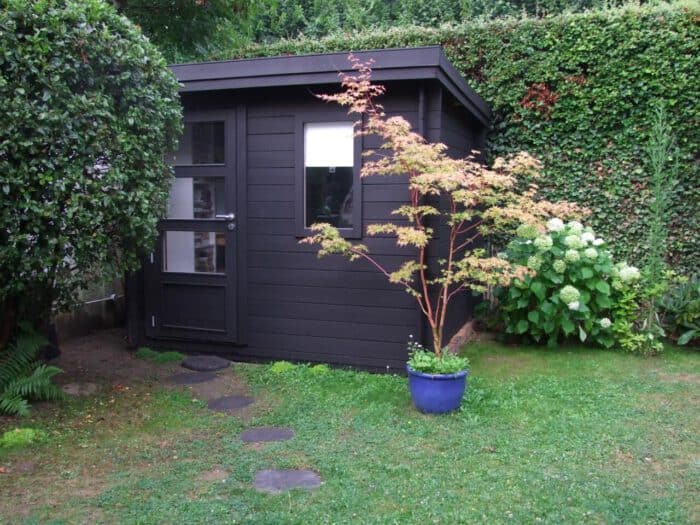
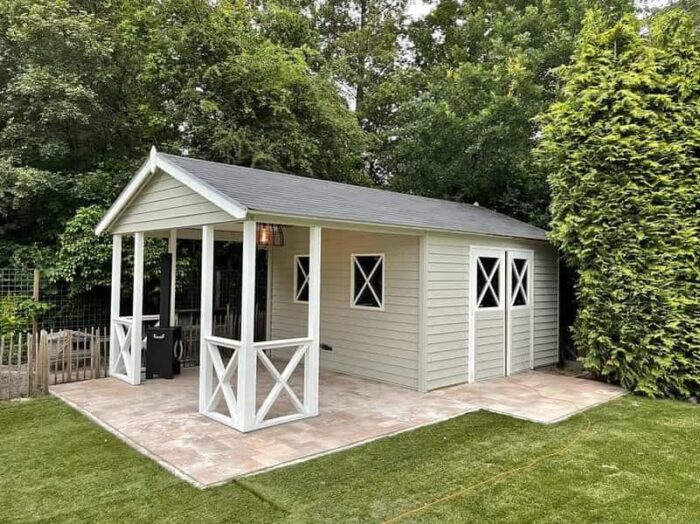
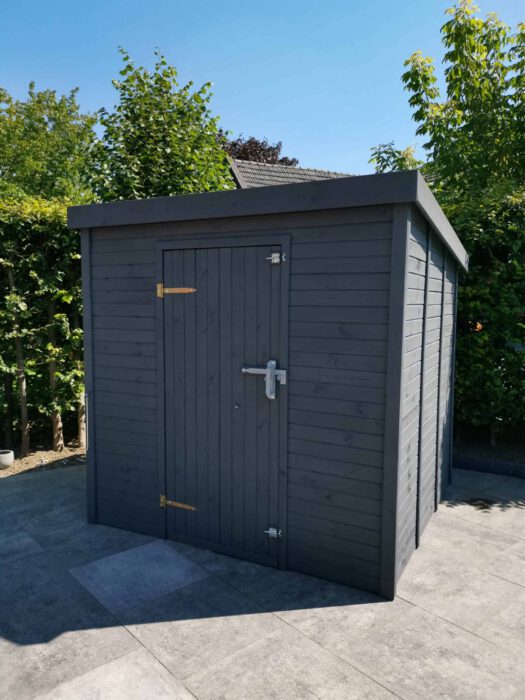
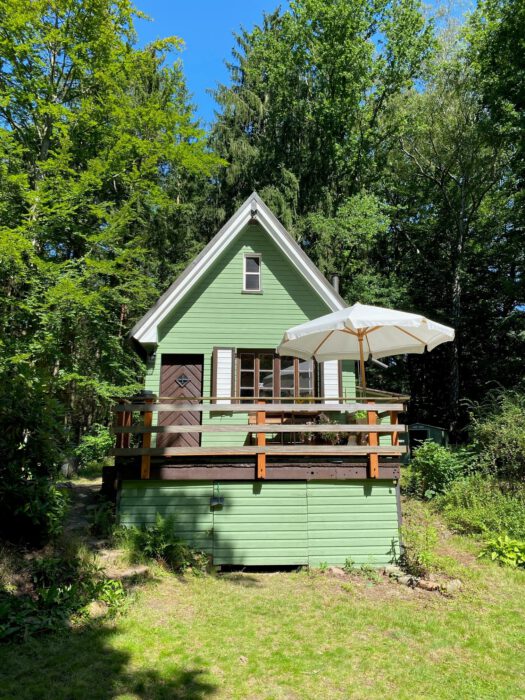
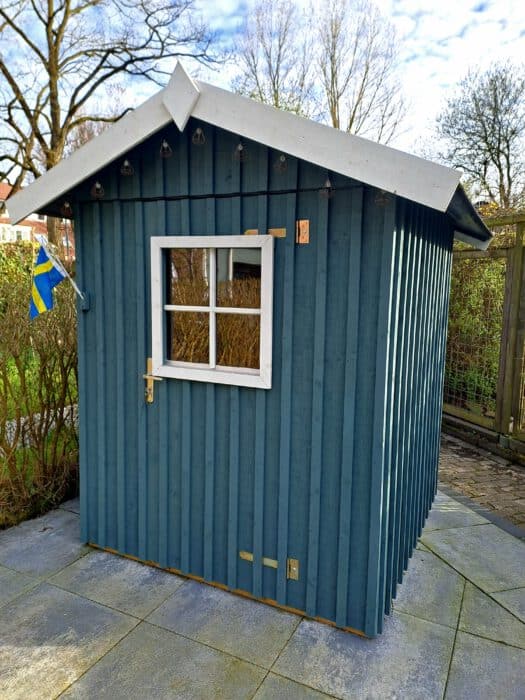
Looking for more inspiration?
Useful tips for choosing the right colour
In different daylight, our colours can look slightly different. Below you’ll find three ways to get a good impression of the colours.
Colour chart
Assess our colours exactly as they are. Hold the card in different daylight to view the colours properly. You can request the hand-painted colour chart free of charge.
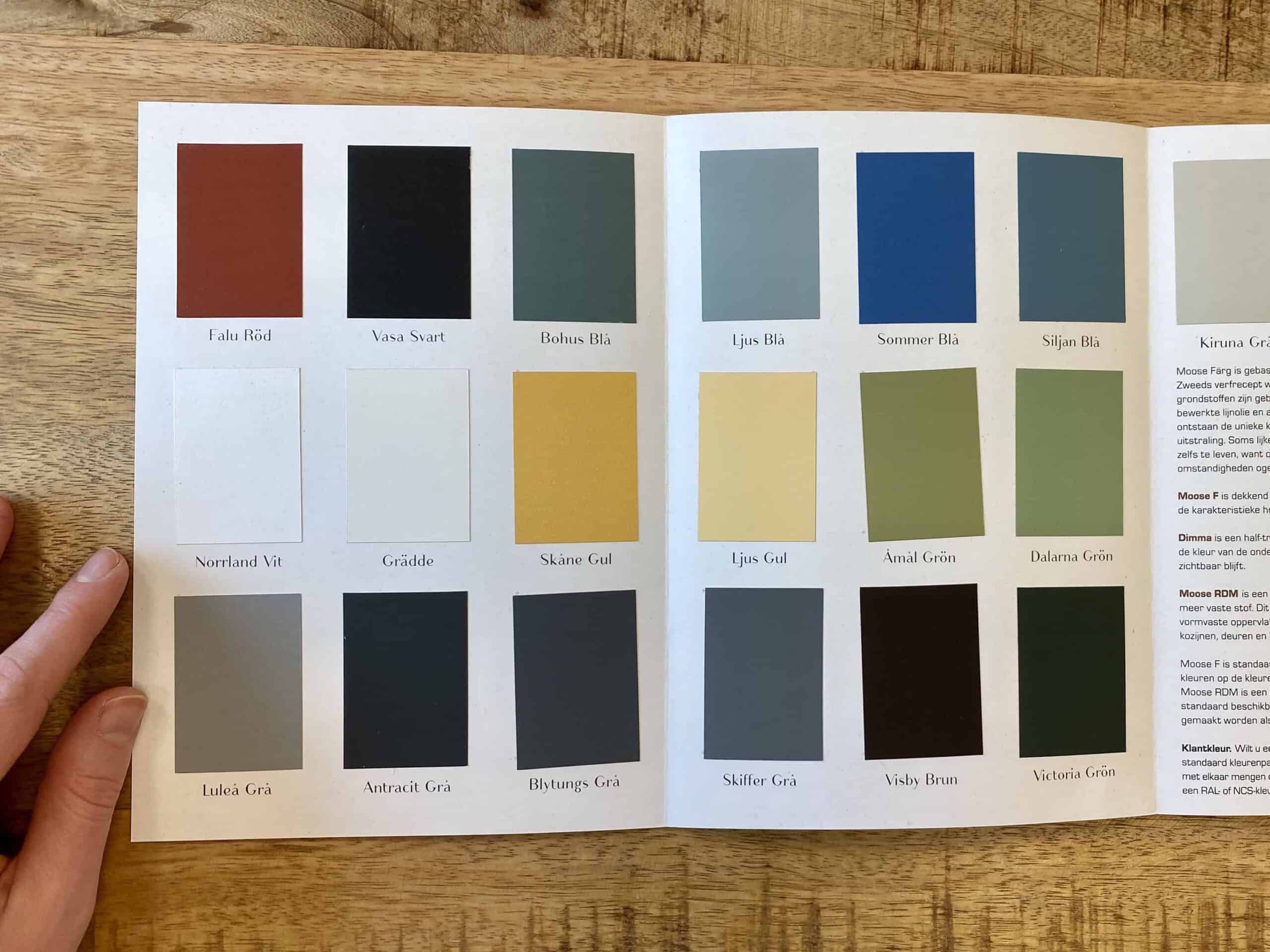
Colour picker tool
If you want to combine several colours, make sure to use our online colour picker tool. With a single click, you can change the colours of the garden shed.
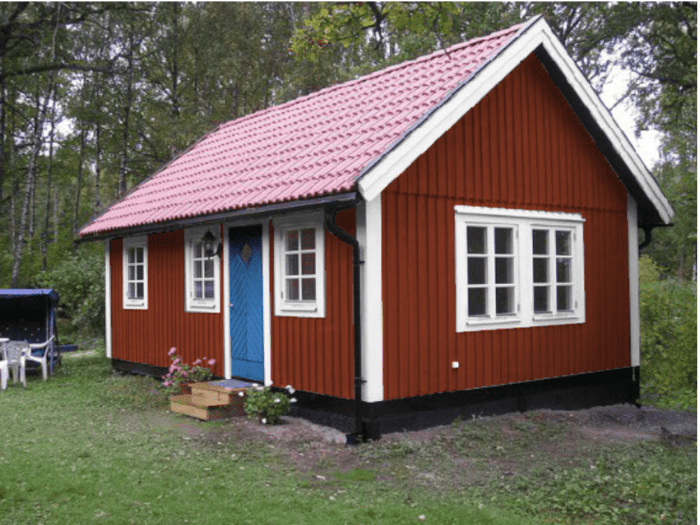
Paint sample
Try out our colours at home. This way, you can see exactly what a colour will look like on your own project. No better way to make a choice! Order a paint sample.
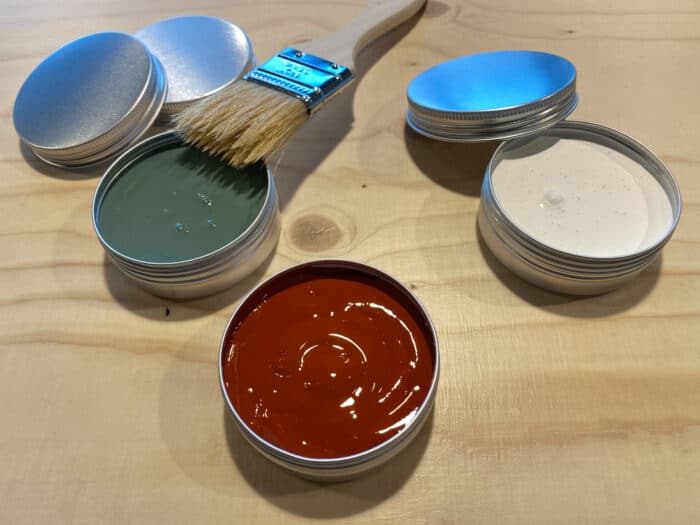
Frequently asked questions about painting a summer house or garden shed
If you want to paint your garden shed or summerhouse, it is best to do this at a temperature above 15 °C. If you paint at a lower temperature, the paint will not dry properly and there is a chance that the rain will wash off the paint before it has dried.
Humidity also plays an important role in the drying process of the paint. When the humidity is very high, the drying process takes more time. In the months of April, May, June, August and September there are many days with a higher temperature and lower humidity. Perfect for painting!
It is no problem to use Moose Färg paint at high temperatures or directly in the sun. If you do so, it is recommended though to dilute the paint with extra water, because the paint will dry very quickly. This enhances the chance of visible brush marks.
Temperature and humidity play a major role in drying time. If you are going to paint at a temperature above 15 °C, the paint will be dust-dry after a day It is then good for the second layer. The paint is completely hardened after a week. Until then, make sure to protect it from any rain.
By impregnating the wood, substances are added to the wood that extend the lifespan of the wood. This mainly happens with wood species that are naturally less durable, such as Douglas, Spruce and Pine.
If you use paint from Moose Färg, you do not need to impregnate with another product. You apply the paint directly to the wood of your summer house, a primer coat is not necessary. Moose Färg offers sufficient protection for your wooden summer house.
Yes, that’s definitely possible. Leave your garden house for a while so the wood can settle and ‘sweat out’ the impregnation substances. If the wood is dirty or greasy, it is important to clean the wood beforehand. This can be done with soapy water with eco-friendly linseed oil soap Polarsken. Is the wood new and smooth? Then sand well before painting with a coarse grain (80).
Due to the vapour-open character of Moose Färg, it is not a requirement to paint on both sides. With lacquer paint this is required, because the wood can warp when you paint it on one side. But, as Moose Färg is breathable paint, you can simply paint the wood on one side.
But, if you like to do so, you can of course paint the inside of your garden house. It gives extra protection to wood on the inside and a pleasant appearance.
Wood of garden houses often have a relatively open structure and are sensitive to penetration of water. Moose Färg provide a water-repellent layer, while at the same time allowing the wood to “breathe”.
If you have a wooden decking or veranda, it is important to prevent moisture penetration. Because it is horizontal wood, water stays on it for a long time. This breaks down the cellulose cells and can cause rot in the long term. The wood weathers more quickly. Moisture penetration causes extra shrinkage and expansion which ultimately results in cracks in the wood.
This is easily counteracted with Pansar water-repellent preservation. This two-step treatment is based on nanotechnology, consisting of a silicone layer and an oil layer. It creates a water repellent layer on top of the wood which prevents water penetration. It protects against uv-radiation, fungi, rot, algae, spores, weathering, cracking and deformation due to water absorption.
Would you like additional, personal advice?
We are happy to help. Send an e-mail or call +31(0) 6 55 333 165. Watch our Instruction Video for more information. Apply here for a free color-card.


